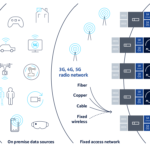As networking evolves to a more modern, innovative approach known as the “New IP,” much of the change is occurring at the edge of the network.
The network edge isn’t always a physical place anymore as much as it is a set of activities. It’s where the user interfaces and interacts with an application—it can be a data center, a home office, or the beach. Even though the application lives in the cloud or in the data center, users can be anywhere they want to be, and the network edge moves right along with them.

The new network edge
As a user interacts with data or an application, the services and policies that control the interaction need to be applied. The actions will vary based on who they are, where they are, and what network and what rights they have. For instance, policies can be applied and expressed through network services such as routing, firewalls, and Quality of Service (QoS).
Today, just about any service can be virtualised, so where this wrapper of policy occurs can be anyplace, just like the application. The network edge is wherever this activity is happening. Policies can be pushed to any device with compute capability.
This is where virtual edge software and services fit into the picture, often called the virtual Customer Edge (vCE) or virtual Customer Premise Equipment (vCPE), depending on the type of deployment by the Telco/Service Provider for that particular customer. In the case of vCPE, a stack of equipment, such as physical routers, firewalls and load balancers can be replaced with virtualized versions of these services that can run on existing servers. In the case of vCE, the Service Provider merely provides a simple network connection with all the services pulled back to a central location in the Service Providers’ cloud-based data centers.
Self-service delivery and cost savings
One immediate benefit of this architecture is that it will drastically reduce “truck rolls” to customer sites to install hardware-based equipment when requested; and having to physically visit the customer site again to retrieve the equipment when no longer required. These savings alone can more than pay for the server and virtualized network services at each site.
In addition, because these network services are software-based and virtualized, they can be deployed very quickly from a central location, increasing customer satisfaction and increasing revenue for Service Providers. This is one of the key concepts of the New IP.
Be SDN-ready
An easy first step to embrace the new edge—and the New IP in general—is to make sure that the edge devices have capabilities to support software-defined networking (SDN), a key element of the New IP. The ability to manage these devices through OpenFlow and an SDN controller provides a great foundation for programmability.
In the future, it will be increasingly important that edge devices support SDN protocols such as OpenFlow, as well as management protocols such as sFlow, to programmatically control the physical edge.
There are many ways to get started on the New IP journey, and the network edge provides a great area where real business value can be added.
###








